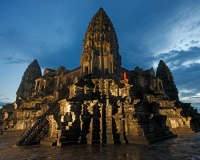Angkor (802 AD)
Hindu Archeological Temple
Angkor, situated in modern day Cambodia, is renowned as one of the most important archaeological sites in South-East Asia. Formerly the centre of the Khmer Kingdom, the area is now a UNESCO protected world heritage site, covering around 400km2, including the famous temples Angkor Wat and Bayon Temple, and forests. The protected area consists of more impressive monuments besides Angkor Wat, several different ancient urban plans and large water reservoirs. Angkor possesses a unique concentration of cultural and archaeological features, which testify to an exceptional civilisation. This rich cultural heritage and significance attracts a great deal of visitors to the site from across the world, keen to expand and enrich their knowledge of a vastly different culture to their own. Especially for tourists and observers from the geographical west, where perspectives of culture in South-East Asia may perhaps have been limited, Angkor Wat offers an insight into understanding the cultural history of others. Such insights have a strong relevance for cultural diplomacy today.
